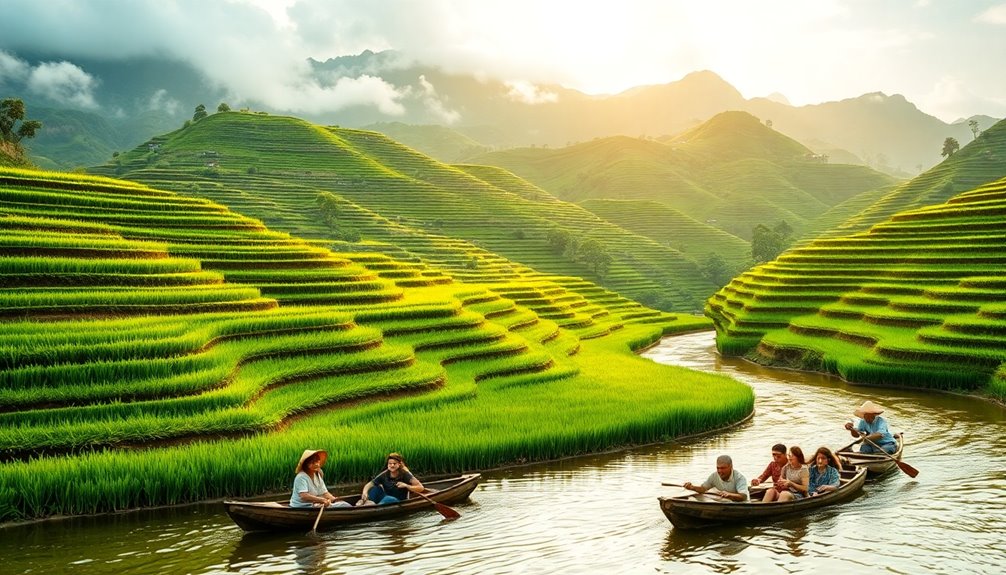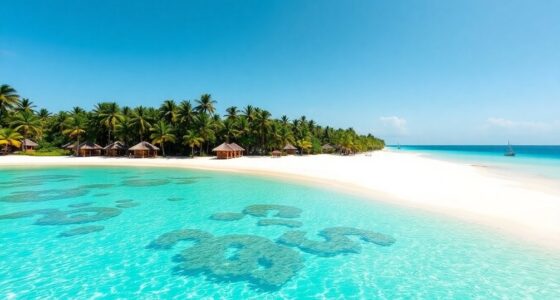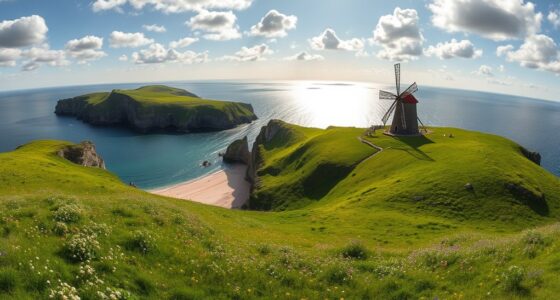Vietnam's stunning landscapes offer you countless green adventures that promote sustainability. You can explore UNESCO-listed Phong Nha-Ke Bang National Park, kayak in the serene waters of Ba Be, or cycle through vibrant agricultural areas. Engage with local artisans in workshops that emphasize eco-friendly practices, or savor farm-to-table meals in Tra Que Vegetable Village. By choosing eco-conscious tours and supporting community-led conservation efforts, you'll contribute to preserving the environment. Time your trip during the dry season for the best trekking conditions and unique local experiences. Keep going to uncover more about Vietnam's sustainable wonders!
Key Takeaways
- Explore diverse ecosystems through eco-friendly wildlife tours, kayaking, and sustainable lodgings in Vietnam's national parks and natural landscapes.
- Engage in cultural immersion by participating in local artisan workshops and organic farming experiences that preserve traditional skills and promote sustainability.
- Rent bicycles for an eco-conscious way to discover Ba Be National Park while supporting local businesses and reducing your carbon footprint.
- Join community-led conservation programs and reforestation projects that highlight the importance of local engagement in preserving biodiversity and natural habitats.
- Visit during the dry season for optimal trekking conditions and to experience the beauty of harvest seasons while connecting with local agricultural practices.
Introduction
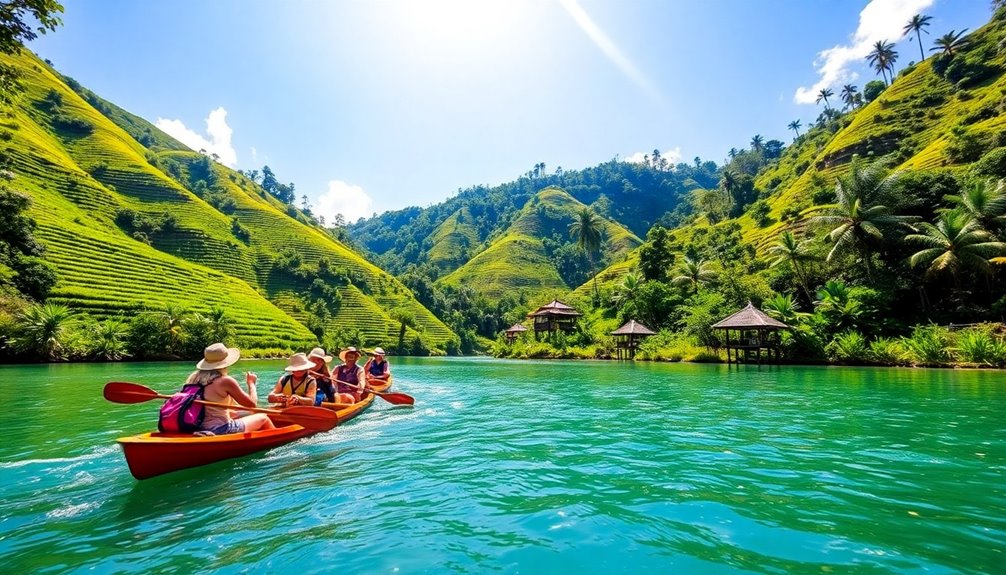
When you explore Vietnam, you'll discover its stunning ecosystems and landscapes that are rich in biodiversity.
You'll also experience cultural immersion through sustainable practices that connect you with local communities.
This journey not only enhances your adventure but also supports the country's commitment to eco-friendly tourism.
Vietnam's Diverse Ecosystems and Landscapes
Vietnam boasts a remarkable array of ecosystems and landscapes that invite exploration and appreciation. The country's commitment to sustainable tourism ensures that you can experience its rich biodiversity while supporting local communities.
Visit Phong Nha-Ke Bang National Park, a UNESCO World Heritage site, where stunning limestone karst formations and extensive cave systems hide unique flora and fauna, including endangered species.
Discover Ba Be National Park, home to Vietnam's largest natural lake, and marvel at rare species like the Francois langur.
In Con Dao National Park, dive into pristine coral reefs teeming with marine life.
The Mekong Delta, with its intricate rivers and swamps, offers a vibrant agricultural landscape that sustains local livelihoods while showcasing the country's natural beauty.
Cultural Immersion Through Sustainable Practices
While exploring the vibrant culture of Vietnam, you can immerse yourself in sustainable practices that benefit both the environment and local communities.
Engage with local artisans and organic farmers through community-focused initiatives that highlight the country's rich cultural heritage. For instance, the Art of Green Tour in Hội An offers hands-on activities like bamboo workshops and upcycling art projects, allowing you to connect with eco-friendly traditions.
At Tra Que Vegetable Village, enjoy meals prepared from local produce, reinforcing the importance of supporting sustainable agriculture.
These experiences not only enhance your travel adventure but also contribute to the preservation of traditional crafts and local ecosystems.
Embrace Vietnam's commitment to sustainability while enriching your journey through meaningful cultural immersion.
Travel From Hanoi to Ba Be
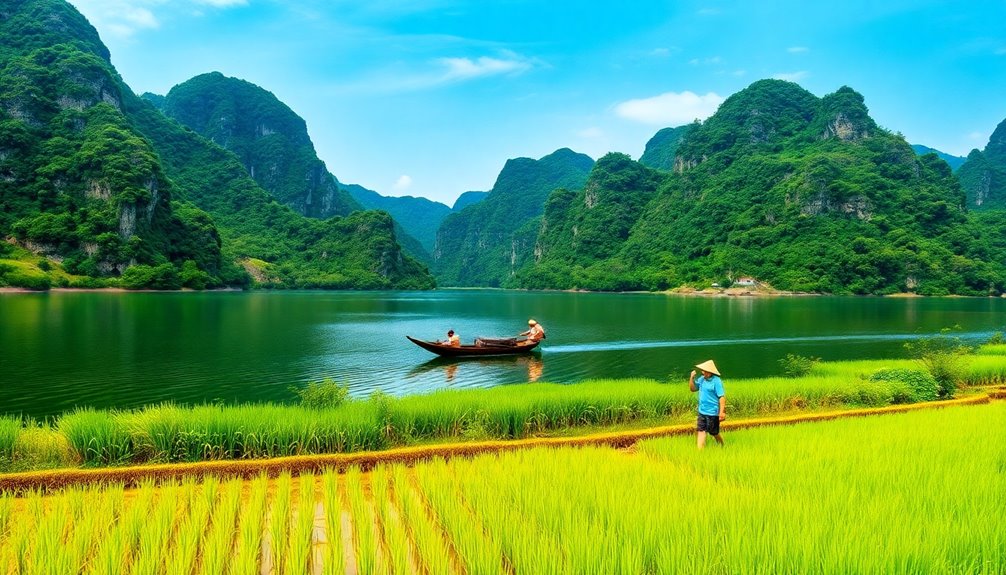
If you're planning to travel from Hanoi to Ba Be, you've got some options to consider.
Whether you're flying in from cities like Los Angeles or Sydney or taking a scenic route from Paris, the journey can be an adventure in itself.
Once you arrive, you can even rent a bicycle to explore the park sustainably while soaking in its breathtaking landscapes.
Fly From Los Angeles Direct
When you fly from Los Angeles to Hanoi, you'll find yourself just a few steps away from the breathtaking Ba Be National Park.
The flight typically takes around 13 to 15 hours, with options for direct or connecting flights. Once you arrive in Hanoi, you can explore the local sustainable tourism options to reach Ba Be, located approximately 240 km away.
A scenic 6-hour drive or a private tour will take you to Vietnam's largest natural lake, Ba Be Lake, surrounded by stunning landscapes.
This park, recognized for its ecological significance, is home to rare species like the endangered Francois langur.
Timing your visit during the harvest or green seasons enhances your experience of its natural beauty.
Travel From Paris to Ba Be
After soaking in the vibrant culture of Hanoi, you're ready to venture to Ba Be National Park, a gem of natural beauty just 240 km away.
A six-hour drive takes you through stunning landscapes, perfect for eco-conscious travelers seeking adventure and tranquility. Various tour operators offer guided trips that connect you with the local community, enriching your experience.
At Ba Be, you'll encounter Vietnam's largest natural lake, teeming with rare wildlife, like the Francois langur, underscoring the park's commitment to wildlife conservation. Routine health checks for local wildlife populations are essential in ensuring their well-being and sustainability.
Immerse yourself in nature through trekking and bird watching, while engaging with local ethnic groups that emphasize sustainable tourism.
This journey not only revitalizes your spirit but also supports vital conservation efforts.
Fly From Sydney to Hanoi
Flying from Sydney to Hanoi is a straightforward journey that opens the door to Vietnam's rich culture and stunning landscapes.
As a nature lover, you'll find that Ba Be National Park, just a 6-hour drive from Hanoi, is a must-visit. Embrace responsible tourism and explore this biodiverse haven, home to rare species like the Francois langur.
To enhance your experience:
- Visit Ba Be Lake, Vietnam's largest natural lake.
- Enjoy the scenic rice terraces during harvest season (September to November).
- Discover the park's rich flora, including various orchids.
- Engage with local communities to learn about their cultural heritage.
This adventure promises unforgettable memories while respecting the environment and its people. Additionally, engaging with local communities can foster strong attachment that enhances emotional and social development in children.
Bicycle Rentals for Eco-Friendly Travel
Exploring Vietnam's stunning landscapes doesn't have to end when you leave Hanoi. You can take advantage of bicycle rentals for an eco-friendly adventure to Ba Be National Park, a scenic 240 km journey.
Cycling this route, which takes about 6 hours, immerses you in lush landscapes and offers a unique glimpse into local culture. As you pedal through charming villages, you'll witness traditional farming practices and connect with the community.
This sustainable tourism option not only reduces your carbon footprint but also supports local businesses. Once you reach Ba Be, enjoy its breathtaking rice terraces and rich biodiversity, making your trip both memorable and responsible.
Embrace the green side of travel and experience Vietnam like never before!
Eco-Conscious Wildlife Encounters

When exploring Vietnam's natural beauty, you can immerse yourself in eco-friendly wildlife tours that highlight the country's unique ecosystems.
Consider kayaking on tranquil waters, where you can appreciate the scenery while minimizing your impact on the environment.
Plus, staying in sustainable lodgings powered by solar energy ensures your trip supports conservation efforts.
Eco-Friendly Wildlife Tours
While enjoying the breathtaking landscapes of Vietnam, you can immerse yourself in eco-friendly wildlife tours that showcase the country's incredible biodiversity.
These tours not only let you observe rare and endangered species but also contribute to vital conservation efforts.
Here's how to make the most of your experience:
- Visit Cuc Phuong and Con Dao National Parks to see species like the Francois langur in their natural habitats.
- Engage in sustainable travel practices by choosing tours that emphasize responsible wildlife viewing.
- Participate in educational programs to learn about local ecosystems and the importance of biodiversity.
- Support local economies as a portion of your tour fees often funds habitat restoration and community development programs.
Your journey can make a difference!
Eco-Friendly Kayaking Adventures
After soaking in the wonders of Vietnam's wildlife on eco-friendly tours, you can take your adventure to the next level with kayaking.
Paddle through breathtaking locations like Ha Long Bay and the Mekong Delta, where you'll experience serene waterways while keeping your ecological footprint low.
Many kayaking tours focus on wildlife encounters, allowing you to spot unique species such as endangered dolphins and vibrant birds in their natural habitats.
Guided by local experts, you'll learn about environmental conservation and the importance of protecting fragile ecosystems.
Tour operators prioritize responsible tourism by using sustainable equipment and waste reduction strategies, ensuring your adventure positively impacts the environment while supporting local communities through income opportunities and educational initiatives.
Sustainable Lodgings Powered by Solar
As you explore Vietnam's natural beauty, consider staying in sustainable lodgings powered by solar energy, which not only reduce your carbon footprint but also enhance your overall travel experience.
These eco-lodges embrace sustainable practices, harnessing renewable energy to provide clean electricity for your needs while promoting biodiversity conservation. Additionally, these lodgings often utilize Merkle trees to ensure data integrity and efficiency in managing their operations.
Here are four ways to enjoy your stay:
- Participate in wildlife encounters in areas like Phong Nha-Ke Bang National Park.
- Enjoy amenities powered by solar energy, ensuring a minimal environmental impact.
- Support local communities by choosing accommodations that prioritize sustainability.
- Engage in eco-friendly activities, such as composting and recycling, during your visit.
Support Local Eco-Friendly Businesses
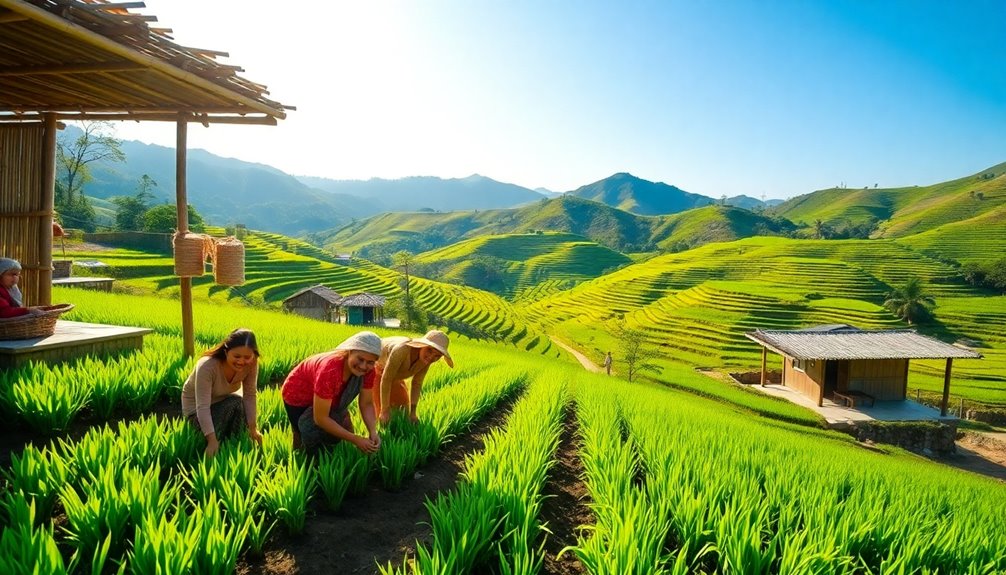
Supporting local eco-friendly businesses in Vietnam not only enriches your travel experience but also plays a crucial role in promoting sustainable tourism.
When you choose to dine at restaurants in Hội An that serve meals made from locally sourced ingredients, you support community welfare and regional agricultural sustainability.
Buying handmade goods from local artisans helps preserve cultural heritage while reducing the environmental impact of mass production.
Engaging in tours with sustainable operators, like Oxalis Adventure, allows you to connect with nature responsibly and contribute to local conservation efforts.
Additionally, participating in workshops such as the Taboo Bamboo Workshop deepens your understanding of innovative sustainable practices, reinforcing the importance of supporting local eco-friendly businesses for a healthier planet and thriving communities. Moreover, this approach aligns with the principles of sustainable tourism which aims to minimize environmental impact while enhancing the quality of life for local residents.
Community-Led Reforestation Projects
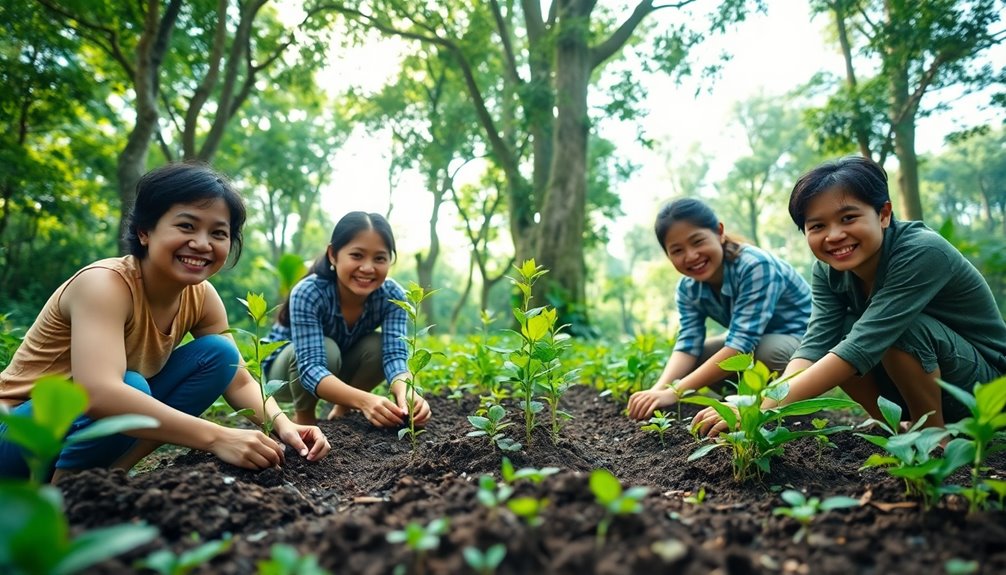
When you look at community-led reforestation projects in Vietnam, you'll see a powerful blend of government and NGO efforts that support local initiatives.
These collaborations not only restore ecosystems but also embrace cultural sustainability by involving local knowledge.
Government and NGO Efforts
Community-led reforestation projects in Vietnam showcase the power of local engagement in environmental restoration. The government and NGOs work together, facilitating the planting of millions of trees to enhance biodiversity and improve air quality.
Here are some key aspects of these efforts:
- One Million Trees Program: This initiative encourages community involvement in sustainable forestry practices.
- Educational Programs: Local schools participate, raising awareness about forest conservation and biodiversity.
- Wildlife Recovery: Successful reforestation has led to increased populations of endangered species.
- Carbon Sequestration: Trees planted contribute significantly to reducing carbon footprints.
Through these collaborative efforts, communities gain a sense of ownership over their natural resources, fostering a sustainable future for Vietnam's ecosystems.
Community and Cultural Sustainability
While reforestation projects in Vietnam focus on restoring ecosystems, they also empower local communities by providing sustainable livelihoods through eco-friendly practices.
These community-led reforestation projects involve planting native tree species, enhancing biodiversity, improving soil quality, and preventing erosion. By collaborating with local organizations, you gain valuable knowledge about sustainable land management, fostering a sense of ownership and responsibility for your environment.
These initiatives not only promote environmental awareness but also weave in local traditions, strengthening cultural ties. As you actively participate in tree planting and conservation activities, you help combat climate change while boosting community engagement.
This engagement leads to enhanced social cohesion and resilience, creating a brighter, more sustainable future for everyone involved.
Dry Season for Trekking
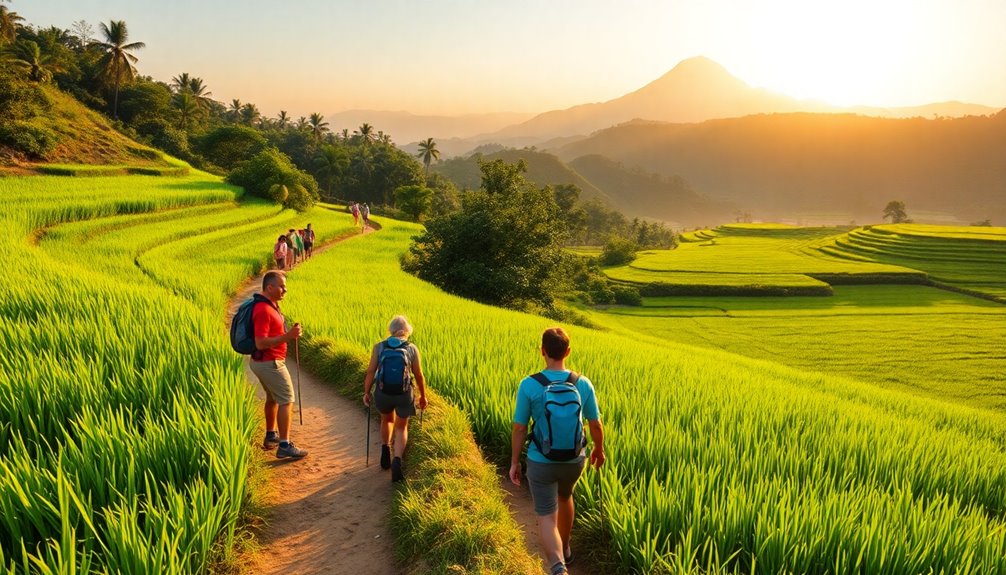
If you're planning a trekking adventure in Vietnam, the dry season from November to April is your best bet.
With less rainfall and cooler temperatures, you'll find the trails in regions like Sapa and Mai Châu more accessible and enjoyable.
Understanding seasonal rainfall patterns can help you make the most of your trekking experience while immersing yourself in the local culture.
Best Months for Trekking
The best months for trekking in Vietnam fall between November and April, when the dry season brings minimal rainfall and clear skies. This period offers the best trekking conditions, especially in northern Vietnam.
If you're planning your adventure, consider these tips:
- Go between December and February for cooler temperatures in Sapa, ensuring lush landscapes.
- Explore central Vietnam from January to August, where Phong Nha-Ke Bang National Park awaits with stunning caves.
- Enjoy breathtaking views without muddy trails or heavy rain, enhancing your hiking experience.
- Witness vibrant rice terraces during the local harvest season from September to November for a unique cultural touch.
Embrace the dry season for unforgettable trekking in Vietnam!
Seasonal Rainfall Patterns Impact Travel
Seasonal rainfall patterns significantly impact your travel plans in Vietnam, especially during the trekking season. The dry season from November to April offers the best conditions for outdoor activities, with minimal rainfall and comfortable temperatures. Northern regions like Sapa and Mai Châu become vibrant with lush landscapes, perfect for exploring terraced rice fields and ethnic minority villages. Clear skies and excellent visibility during this time enhance your trekking experience, providing breathtaking views. In contrast, the rainy season from May to October can create muddy trails and safety concerns. Prioritizing the dry season for your treks ensures a more enjoyable adventure.
| Season | Best for Trekking | Weather Conditions |
|---|---|---|
| Dry Season | Yes | Clear skies, warm temps |
| Rainy Season | No | Muddy trails, landslides |
| Ideal Months | Nov – Apr | Comfortable, safe trekking |
How to Make Your Trip More Sustainable
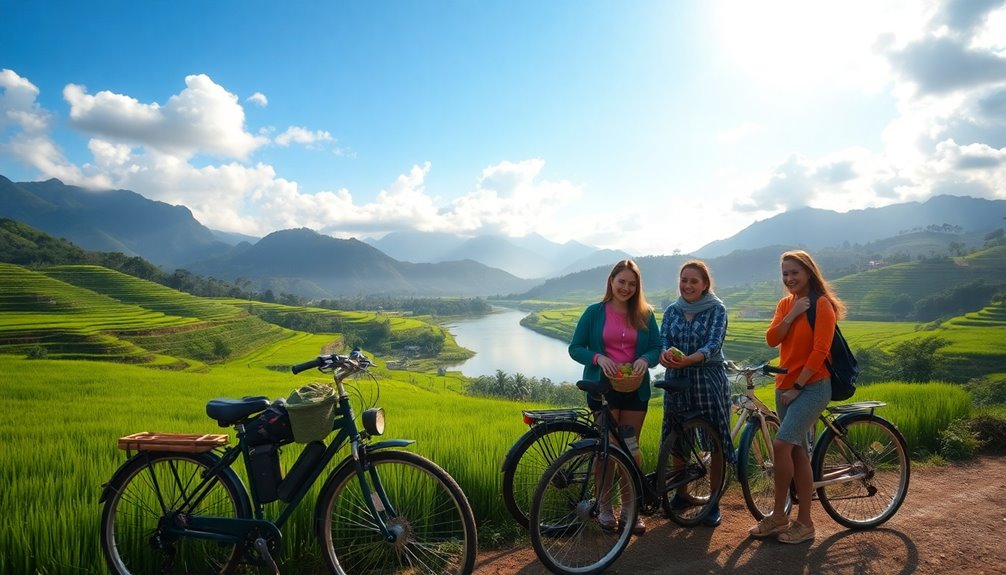
To make your trip more sustainable, start by packing biodegradable toiletries that minimize waste. You can also support local artisans by purchasing their crafts, which not only helps preserve traditional skills but also boosts the local economy. Additionally, being mindful of your spending can lead to higher net retirement income, which ultimately allows you to contribute more to sustainable practices during your travels. These small choices can have a big impact on the environment and local communities.
Biodegradable Toiletries for Travel
When planning your next adventure, consider swapping out conventional toiletries for biodegradable options that not only keep you clean but also protect the planet.
Using biodegradable toiletries helps reduce plastic waste, contributing to a more sustainable tourism experience. Many of these products decompose within 90 days, unlike traditional toiletries that linger for centuries.
Plus, they often use natural ingredients, minimizing harmful chemical contamination in local ecosystems. Supporting this eco-friendly choice aligns with the growing movement towards sustainable travel options, which seeks to preserve natural habitats while enhancing travel experiences.
Here are four biodegradable toiletries to pack:
- Bamboo toothbrushes
- Organic soaps
- Biodegradable wet wipes
- Travel-sized shampoo bars
Support Local Artisans' Crafts
Supporting local artisans' crafts is a fantastic way to make your trip more sustainable and enriching. When you choose to buy handmade crafts, you directly support local artisans, providing them with income while preserving traditional skills and cultural heritage.
Engage in workshops like the Taboo Bamboo Workshop, where you can create your own bamboo mementos and learn about sustainable materials. Visit Coco Casa along the Co Co River to see how artisans transform driftwood into stunning upcycled art, promoting eco-friendly practices.
Additionally, participating in sustainable initiatives at Tra Que Vegetable Village allows you to enjoy delicious meals made from locally sourced organic produce. By selecting tours that include artisan workshops, you enhance your travel experience and contribute to sustainable tourism.
Frequently Asked Questions
What Is Vietnam Doing for Sustainability?
Vietnam's making significant strides in sustainability.
You'll find eco-tourism initiatives that promote responsible travel, helping to protect local cultures and environments.
The country's focused on turtle conservation, engaging communities in monitoring nesting activities.
You can also see renewable energy efforts, with tour operators investing in solar panels to cut down on fossil fuel reliance.
What Is the Sustainable Tourism Initiative in Vietnam?
Vietnam's sustainable tourism initiatives focus on preserving nature, supporting local economies, and enhancing cultural heritage.
You'll find eco-friendly practices in action as local operators engage communities, reduce waste, and promote renewable energy.
By participating in tours that connect you with artisans and farmers, you contribute to sustainable living.
Exploring destinations like Phong Nha-Ke Bang National Park allows you to enjoy the natural beauty while actively participating in conservation efforts.
Your travels can truly make a difference!
What Is Green Sustainable Tourism?
Green sustainable tourism focuses on minimizing your environmental impact while promoting conservation and cultural heritage.
It encourages you to choose eco-friendly accommodations, support local businesses, and engage in activities that benefit both the environment and community.
By participating in this approach, you connect with local ecosystems and traditions, raising awareness about biodiversity and environmental issues.
Ultimately, it helps generate income for local communities, making your travel both responsible and enriching.
What Are the Most Sustainable Companies in Vietnam?
You mightn't realize it, but choosing the right travel company can make a huge difference.
In Vietnam, companies like Oxalis Adventure, 365 Travel, and Sapa Sisters stand out for their commitment to sustainability. They focus on eco-friendly practices, support local economies, and promote cultural exchange.
Grasshopper Adventures offers customizable cycling tours, while YESD encourages participation in conservation efforts.
These companies not only enhance your travel experience but also help protect Vietnam's stunning environment.
Conclusion
You might think sustainable travel means sacrificing comfort, but that's far from the truth in Vietnam. By choosing eco-friendly adventures, you'll immerse yourself in breathtaking landscapes while supporting local communities. Picture trekking through lush jungles, spotting rare wildlife, and enjoying locally-sourced meals—all without leaving a negative footprint. Embrace the thrill of adventure and the satisfaction of knowing you're making a positive impact. Vietnam's stunning beauty and commitment to sustainability are waiting for you.

